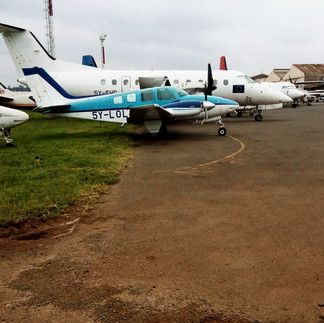Deconstructing Aircraft Registration Marks
- Captain Alexander
- Aug 13, 2021
- 3 min read

In the same way automobiles, motorbikes, and heavy commercial vehicles have number plates, aircraft too, have unique identifiers which are placed at specific areas on the fuselage (aircraft body), wings, vertical tail plane and landing gear doors.
These identifiers feature the country of origin (nationality mark)as you'd expect, as well as other permutations of letters and numbers called registration marks to help differentiate that aircraft from the next in a particular airline's fleet
For those who are frequent flyers, or if you are a keen observer of aircraft, I'm pretty sure you have seen something like 5Y-NSM, ET-APQ, G-AXDN or B-1123 and so on and so forth.
These are typical aircraft identification marks and as you can see, there are different variations that exist, in that, some have a combination of letters only while others have both numbers and letters. These identification marks feature five or six characters with exceptions made in some cases to special aircraft such as ultralights, vintage aircraft and even experimental aircraft.
Some aircraft owners also tend to be very creative when coming up with registration marks for their aircraft with some bearing people's names, others with those acronyms and short forms we use when texting, some with the airline name (see 5Y-ELO of Yellow Wing Air Services Ltd.), another with religious references (see 5Y-ESU of MAF Kenya); -YESU is Swahili for Jesus- and others like the last two in the grid are just..............
An airline can also decide to assign registrations corresponding to family ties to some of their aircraft, like what the Icelandic budget airline WOW did for some of its Airbus aircraft.

TF' is Iceland's nationality mark and they registered some of their jets as:
TF-DAD, TF-MOM, TF-BRO, TF-SIS
TF-SON, TF-KID
Pretty cool if you ask me.
So how are these identification marks generated?
Well, for starters, it is good to know that registration marks are a requirement by international aviation law and according to the Paris Convention of 1919, all aircraft are to be registered and have to have a nationality mark as well as a registration mark.
Nationality marks are allocated by the International Telecommunications Union which is an agency of the United Nations while the registration mark is assigned by the state in which the aircraft is registered (State of Registry).
The nationality mark precedes the registration mark and they are separated by a hyphen with exceptions in some cases like Korean Air(HL7624) and Uzbekistan Airways (UK75701) that have continuous number and letter combinations.
A good example is as follows:
For 5Y-KQA, the nationality mark is 5Y, while the registration mark is KQA and all Kenyan aircraft have the nationality mark '5Y'
Here are other examples of aircraft nationality marks and their respective countries.
Country Nationality Mark Aircraft reg.
South Africa ZS,ZT or ZU ZS-SDD
Canada C C-FRTW
Algeria 7T 7T-VJW
Qatar A7 A7-ALF
Korea HL HL8346
China B B-6378
There are however, combinations of letters and numbers that are disqualified from being used in aircraft identification because they correspond to distress codes or internationally accepted communication abbreviations and could bring about confusion when communicating with air traffic control as well as other aircraft.
These include:
SOS (Distress), PAN (Urgency), XXX (Urgency)
'Q' codes used in aviation meteorology (QNH, QRT, QUG etc)
Transponder code digits corresponding to distress, ie: 7500, 7600 and 7700
And as such, you will not see something like A7-PAN or B-7600
Lastly, there are also guidelines as to how and where these identification marks should appear on an aircraft. Regardless of how much the aircraft exterior is pimped up, these registration marks should be visible and placed in the appropriate areas.
Markings are supposed to appear on the under side of the wing, on the fuselage towards the tail or on the upper half of the vertical tail surface.
On the wings, the markings are to be at least 50cm high while on the fuselage and vertical surfaces, they should be 30cm high.

Occasionally, you do see them on the upper side of the wing like the one shown here.
(Reg OK-NEM)

On the landing gear doors, you also sometimes see the last two or three letters forming the registration mark of the aircraft. In this case 5Y-FFB.
Where numbers are involved in the registration, you will see the last three digits on the landing gear door.





















Comments